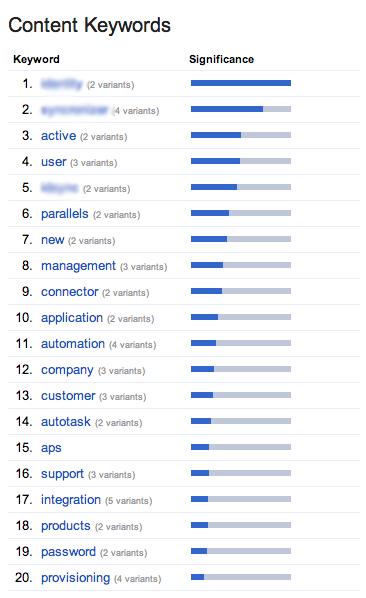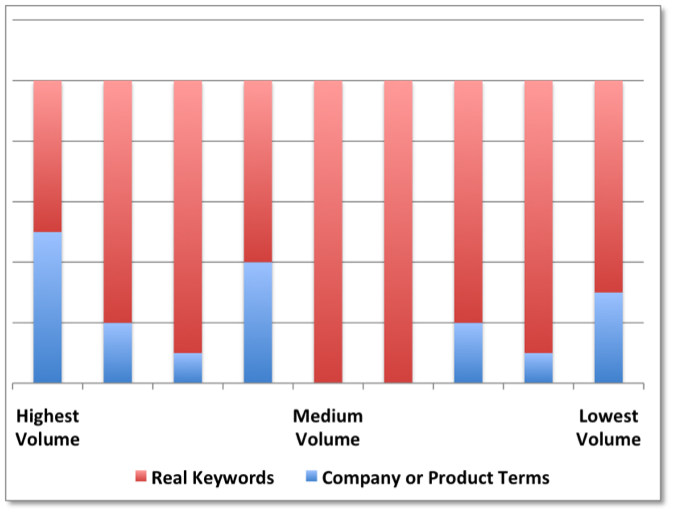One of my favorite features in Google Webmaster Tools is the Content Keywords section. The Content Keywords section provides a list of the most significant keywords that Google found when crawling your website.
 Why is this important? It provides a quick reality check of your website because it is a view of your website through the eyes of Google. It allows you to see how Google interprets the words used on your website, as well as their frequency.
Why is this important? It provides a quick reality check of your website because it is a view of your website through the eyes of Google. It allows you to see how Google interprets the words used on your website, as well as their frequency.
And while Google’s view is important, what I like more is the fact that it helps you see your content through the eyes of someone else.
Product Centric Versus Customer Centric
I use this tool to get a very fast snapshot of a client’s content. By viewing the information from Google I know if the client’s existing website content is product centric or customer centric.
- Product Centric Content – Content is written about the company and it’s product or service offering. Content discusses the product’s features and options only. Product centric websites fail to attract search engines and they fail to convert visitors into leads or sales.
- Customer Centric Content – Content is written with the customer or website visitor in mind. Content discusses a visitor’s pain points (problems or needs), available solutions, and expected outcomes. Customer centric websites better attract search engines and do a much better job of enticing a website visitor into becoming a new prospect or customer.
How Google’s Content Keywords Tool Works
This handy tool lists the top twenty terms Google sees when it crawls and digests a given website. While you can drill down into each word and find greater detail, I like to look at the list as a whole. I like the summary data because it quickly tells me if a website is egocentric (talks and talks about the company name and product names) or visitor centric (uses terms the visitor is familiar with and will use in search).
You may think I’m going out on a limb here, but really I’m not. By looking at the top content words of a given site, you can see if website constantly discusses the company and product offering or actually talks about something the visitor might want/need to read.
In a large number of the Google Webmaster Tools accounts I checked, the website talks more about themselves and their product names in the top content spot.
Don’t believe me? I pulled this data from some random accounts I have access to in Google Webmaster Tools. The chart simply represents product centric versus customer centric terms. Blue represents the words that are included in the company or product name. Red represents more generic terms that could be construed as customer centric terms.

Note: The Keywords list will sometimes exclude words that Google has determined to be boilerplate text or common words. Our website, for example, talks a lot about “websites” but you never see it listed within our Content Keywords.
It is a common mistake of websites to use their verbiage and not the verbiage of the ultimate visitor. While my graph may seem only partially skewed towards company and product terms, it has the top word split. That represents a loss of 50% for connecting with your visitor in both search results and once they ultimately hit your website.
How You Can Become Customer Centric
For each website persona (potential customers) you have, ask yourself the following questions:
- What problems do your potential customers have that relate to your product or service?
- What product or service provides a solution to the above problems?
- How does your product or service address the above problems?
- What benefits will the customer receive from using your product or service?
- What is your value proposition? This would be the outcome or improvement the customer can expect to receive by purchasing your product or service.
Now go back and review what you documented, then do the following:
- Review your existing content and ask yourself if your web pages provide any information on the data you documented above. If it doesn’t, your content needs a rewrite.
- Ask yourself what search terms would relate to the answers provided? This is how real people use search engines and your content needs to match up to these terms so you can both attract visitors to your website and convert them into sales or leads once they arrive.
- Now you have enough data to see some issues with your existing website content and verbiage, which allows you to create a plan to fix this data.
Fixing your website content and turning it into customer centric verbiage is really easier than you would think. Once you change your mindset, you’ll see the issues and you’ll be able to address them quickly.
Web Savvy Marketing
TwitterYoutubeFacebookLinkedinGoogle +